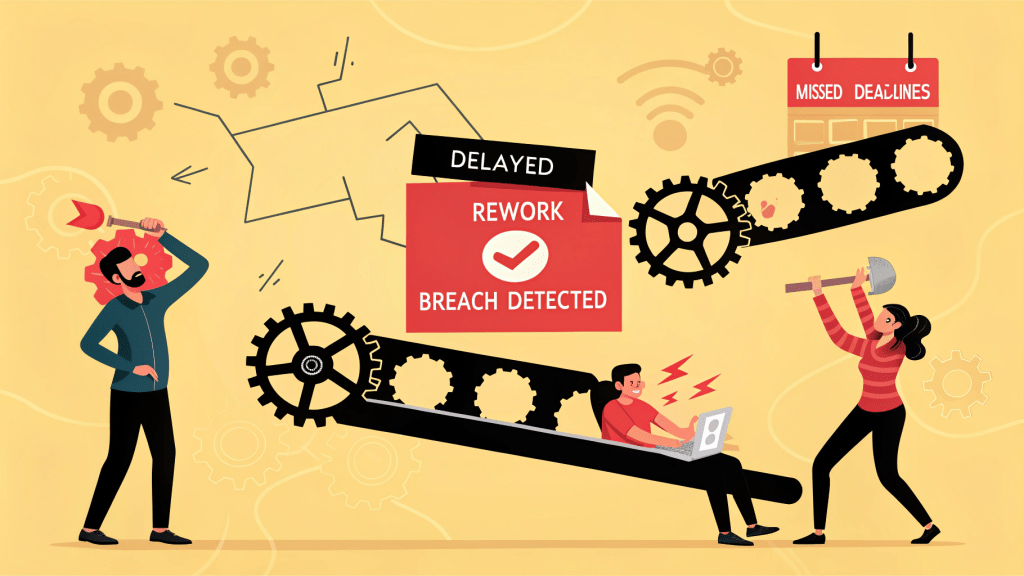Is Your Code a Hacker’s Playground? The Hidden Costs of ‘Security Later’
- The Alarming Truth: Your Software Might Be a Weak Link
- Spot the Signs: Are You Falling into the ‘Security Later’ Trap?
- A Glimmer of Hope: Simple Steps You Can Take Today
- The Unseen Depths: Why DIY Security Isn’t Enough for True Resilience
- Activelobby: Your Invisible Shield. Your DevSecOps Enabler.
- Frequently Asked Questions (FAQs) about DevSecOps
- Ready to Secure Your Innovation?
The Alarming Truth: Your Software Might Be a Weak Link

DevSecOps is no longer optional—it’s essential. In today’s hyper-connected world, software is the lifeblood of every business. But here’s a chilling thought: is the very code you rely on also your biggest vulnerability? Many businesses, driven by the need for speed, still treat security as a dreaded afterthought – a final checklist item before launch. This “security-later” approach isn’t just risky; it’s costing you more than you think.
Imagine building a house and only checking for structural integrity after it’s fully furnished. Sounds absurd, right? Yet, that’s precisely how many development teams approach security. Vulnerabilities, subtle and silent, creep into your codebase during design, development, and testing. By the time they’re found (if they’re found at all), fixing them becomes exponentially more expensive, time-consuming, and potentially catastrophic. We’re talking about fines, reputational damage, customer churn, and a hacker’s field day.
Spot the Signs: Are You Falling into the ‘Security Later’ Trap?

- Delayed Launches: Security reviews consistently bottleneck your release pipeline.
- Costly Rework: Finding critical bugs in production means expensive patches and downtime.
- Compliance Headaches: Struggling to meet regulations because security wasn’t baked in.
- Developer Frustration: Teams see security as an impediment, not an enabler.
- Breach Anxiety: A constant underlying fear of a data breach or cyberattack.
If any of these resonate, you’re experiencing the painful reality of a traditional, fragmented security approach.
A Glimmer of Hope: Simple Steps You Can Take Today

While comprehensive security requires a holistic approach, here are a few actionable tips you can start implementing to “shift left” your security:
- Automate Basic Code Scans:
- TRY THIS: Integrate Static Application Security Testing (SAST) tools directly into your developers’ Integrated Development Environments (IDEs) or your Continuous Integration (CI) pipeline. This helps catch common coding flaws and vulnerabilities as they’re being written, not weeks later. Many open-source options are available to get you started.
- TRY THIS: Integrate Static Application Security Testing (SAST) tools directly into your developers’ Integrated Development Environments (IDEs) or your Continuous Integration (CI) pipeline. This helps catch common coding flaws and vulnerabilities as they’re being written, not weeks later. Many open-source options are available to get you started.
- Foster a “Security-First” Mindset (Small Scale):
- TRY THIS: Encourage a culture where security is seen as everyone’s responsibility, not just the security team’s. Host small, informal workshops for developers on secure coding best practices (e.g., OWASP Top 10). Make it collaborative, not accusatory.
- TRY THIS: Encourage a culture where security is seen as everyone’s responsibility, not just the security team’s. Host small, informal workshops for developers on secure coding best practices (e.g., OWASP Top 10). Make it collaborative, not accusatory.
- Use Vulnerability Libraries for Dependencies:
- TRY THIS: Automate checks for known vulnerabilities in third-party libraries and open-source components. Tools can scan your project dependencies to alert you if you’re using a version with known flaws.
These steps are fantastic starting points, but they often expose a deeper truth…
The Unseen Depths: Why DIY Security Isn’t Enough for True Resilience
Implementing a few tools and practices is commendable, but the reality for most growing businesses is far more complex:
- Scaling Security: How do you enforce consistent security policies across dozens of teams, hundreds of applications, and a constantly evolving infrastructure?
- Tool Sprawl & Integration: Managing disparate security tools, ensuring they “talk” to each other, and consolidating findings becomes a full-time job in itself.
- Advanced Threat Landscape: Automated basic scans are good, but what about sophisticated attacks, zero-day exploits, or complex logic flaws that require deeper analysis?
- Compliance & Audit Burden: Continuously proving compliance across multiple regulations (GDPR, ISO, PCI DSS) without a unified system is a nightmare.
- Talent Gap: Finding and retaining expert DevSecOps engineers who understand both development velocity and deep security is a massive challenge.
This is where the true power of DevSecOps comes into play, and where a strategic partner like Activelobby becomes indispensable.
Activelobby: Your Invisible Shield. Your DevSecOps Enabler.

At Activelobby, we don’t just add security; we embed it. We empower your teams by transforming your entire software delivery pipeline into a secure-by-design fortress, leveraging an extended DevOps operation we call DevSecOps.
Here’s how we transform your security posture:
- 100% Automated Infrastructure & Release Cycles with Security: We build robust CI/CD pipelines that automate everything, from code commit to deployment, with integrated security gates at every step. This means rapid releases without compromising on protection.
- Integrated Security (DevSecOps): We embed comprehensive security tooling (SAST, DAST, IAST, SCA) and practices directly into your workflows. Your code is continuously scanned, tested, and validated for vulnerabilities as it’s being built, not just at the end.
- Proactive Threat Management: Our solutions go beyond basic checks. We implement threat modeling, automated vulnerability management, and continuous monitoring to detect and address risks before they become breaches.
- Compliance Automation: We integrate automated compliance checks into your pipeline, helping you maintain regulatory standards (like ISO 27001, which we are certified in) effortlessly, reducing audit preparation time.
- Strategic Solution Architecture: Our experts assess your current state, visualize your desired secure state, and craft a tailored DevSecOps roadmap, ensuring security aligns with your business goals.
- Right Automation Tools & Techniques: With vast experience across cloud platforms (AWS, Azure) and diverse automation tools, we select and implement the perfect mix for your unique environment, balancing cost, agility, and uncompromising security.
By choosing Activelobby, you’re not just getting a service; you’re gaining an expert partner dedicated to making your software delivery fast, efficient, and resilient against any threat.
Frequently Asked Questions (FAQs) about DevSecOps
Q1: What exactly is DevSecOps?
A: DevSecOps extends DevOps by integrating security into every stage of the software development lifecycle (SDLC) – from planning and coding to building, testing, deploying, and monitoring. It makes security a shared responsibility across development, security, and operations teams.
Q2: How is DevSecOps different from traditional security?
A: Traditional security is often a ‘bolt-on’ at the end of the development process, leading to delays and costly fixes. DevSecOps ‘shifts security left,embedding it early and continuously, making it proactive and preventative.
Q3: Will DevSecOps slow down my development?
A: Initially, there might be a learning curve, but in the long run, DevSecOps significantly accelerates development. By catching and fixing vulnerabilities earlier, you prevent expensive, time-consuming rework and delays later in the pipeline.
Q4: Is DevSecOps only for large enterprises?
A: Absolutely not! Even small to medium-sized businesses (SMBs) face cyber threats. Implementing DevSecOps best practices early on is easier and more cost-effective than trying to retrofit security into a complex system later.
Q5: What kind of tools are used in DevSecOps?
A: DevSecOps leverages a variety of tools for automation, including Static Application Security Testing (SAST), Dynamic Application Security Testing (DAST), Software CompositionAnalysis (SCA), Infrastructure as Code (IaC) security, security information and event management (SIEM), and more.
Ready to Secure Your Innovation?
Don’t let hidden vulnerabilities turn your code into a liability. Activelobby is your expert partner in building a robust, automated, and secure software delivery pipeline.
[Get a Free DevSecOps Consulting Session Today!]
Visit Activelobby.com/DevSecOps to learn more and book your consultation.
